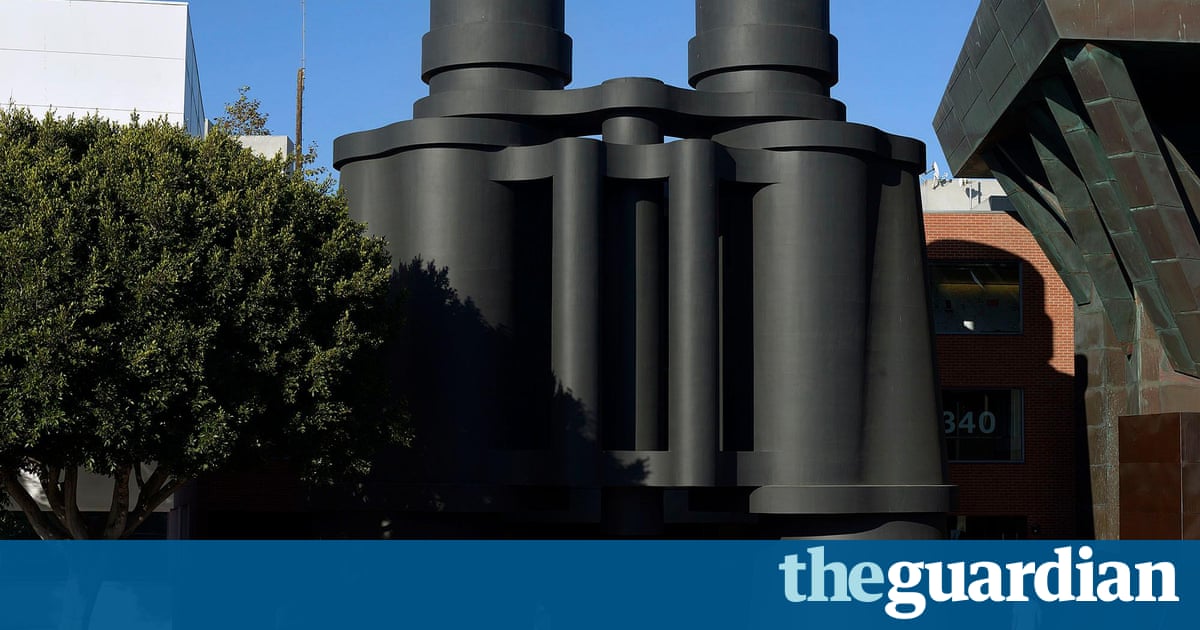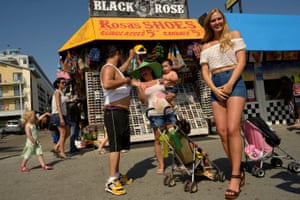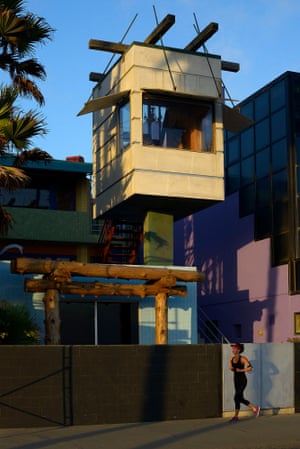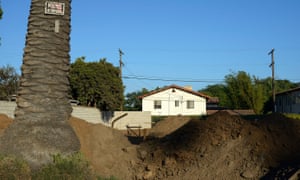The phantom Venice: hunting for Frank Gehry in LA’s strangest neighbourhood
 It was the gaudy Disneyland of its day which beguiled Jim Morrison and Janis Joplin, and now hosts some of Gehrys boldest creations. Stephen McLaren goes treasure hunting for the architects new home and finds a beachfront town that has undergone more reinventions than a Hollywood C-lister
It was the gaudy Disneyland of its day which beguiled Jim Morrison and Janis Joplin, and now hosts some of Gehrys boldest creations. Stephen McLaren goes treasure hunting for the architects new home and finds a beachfront town that has undergone more reinventions than a Hollywood C-lister

Cycling through Venice for the first time in several years, I couldnt help but notice this proudly laid-back beachfront town west of Los Angeles is gradually being remade in jauntily angled boxes of concrete, steel and glass. New wealth is pouring into what was once a slightly scuffed and sleepy neighbourhood, a place that celebrated barefoot living in low-slung wooden cottages.
The style of the new modernist mini-mansions is strongly reminiscent of one man: Frank Gehry, who has a long and abiding connection to Venice. The architect whose buildings are said to revitalise whole cities has been experimenting with manipulating form and materials in Los Angeles for more than 30 years. The angular forms and everyday materials (corrugated metal, chain-link fencing) of his family home, built in 1978 in nearby Santa Monica, has bubbled its way up into his classic buildings: the Guggenheim Museum in Bilbao, or the Disney Concert Hall in Los Angeles.
For decades, Venice has been not just where Gehrys artist and architect friends lived, but where he made some of his most cutting-edge work. In this neighbourhood of charming, cramped cottages, of back alleys overgrown with cactus and bougainvillea and long-forgotten basketball hoops, of hummingbirds zipping in and out of the foliage, Gehrys bold designs have always stood out.
Now, however, cement walls and austere fencing are rising throughout the neighbourhood, shielding new, bespoke, futuristic beach homes just like minor-league Gehrys. With Gehry himself now building a new home in Venice, I decided to see it for myself; armed with newspaper clippings and clues from the internet, I set out on my bike to find it, hoping to get the measure of what is, by all accounts, one of Los Angeless strangest neighbourhoods.

From oil town to countercultural hideaway to weightlifting exhibitionist paradise, Venice has seen more re-inventions than a Hollywood C-lister. It has beguiled luminaries from Jim Morrison to Arnold Schwarzenegger and Julia Roberts, but has also struggled with homelessness and violent crime. Its latest wheeze is secession from Los Angeles entirely: Vexit is being pitched as a way of regaining control of public services and property taxes from Los Angeles, which some regard as domineering and unresponsive to local needs.
Venice has always had a lot going for it. With ultra wide-angle views of the Pacific Ocean and its improbably broad golden beaches, it is perfect for residents who enjoy being close to LA but not too close, and for tourists who make it the second most visited location in the region after Disneyland. The famous boardwalk has always been a rough frontier, from which the more genteel part of LA recoiled with embarrassment: freakshows, drum circles and Schwarzeneggers old body-building haunt Muscle Beach. Now it is also a home to wealthy non-conformists, who have built ostentatious mini-mansions overlooking the cycle path.

Originally conceived as a west coast facsimile of its Adriatic namesake, Venice has also slugged it out as a seaside resort for cheap thrills and, in its most recent guise, a suburban idyll for hi-tech executives at nearby Silicon Beach. The young guns at Snapchat, Buzzfeed, Youtube and Vice are the latest wave of Angelenos to find a pleasant live-work balance in Venice.
When word leaked that Gehry, now 87, was finally building a family home in Venice after originally buying the plot of land in 2004 it made a splash. Newspaper reports from 12 years ago describe a rare triple lot, shaded by a huge palm tree and a fir tree.
Crisscrossing Venices myriad back alleys and lanes, I quickly found myself with a flat tyre, and rolled my bike into Lance The Bike Whisperer Smalls repair store. As a long-time Venice resident, Lance has seen a lot of violence here, especially in the 1980s and 90s when a crack epidemic saw rival gangs fight it out on his doorstep. Things have been calmer in recent years as a result of gentrification, a development he broadly welcomes though he says the newcomers and their architect-designed homes are threatening the neighbourly spirit he remembers.
All these people are used to working and living behind walls, whether it is in their cubicle at work or in their condos, or whatever, he says. So the first thing they do when they move here is build a wall so we cant see them. What happens though when someone gets over the wall and is robbing their home? Now I cant see in there, so I cant tell whats going on, and wont be calling the police.
The new wealth is one of the main reasons for Vexit, the term used by the neighbourhood council to canvass support for the secession of Venice from LA. They argue that poorer districts are benefitting unfairly from the huge amounts of property taxes that their rich enclave now contributes to the citys budget.
Despite highly visible wealth, Venice frets over its own social problems, such as homelessness and drug use among the large transient community frequenting the gaudy boardwalk area. There is also a prevailing view here that these problems are not being dealt with seriously by the Los Angeles municipality. Ironically, in 1925 it was Venice, then an independent municipality, that had to be bailed out by LA when it went bankrupt.
The place has always had an independent spirit. Though ignored by the nascent movie industry, it was conceived by tobacco baron Abbot Kinney as a cultural powerhouse to rival Venice in Italy in the early 1900s. Kinney dug canals, installed gondoliers, built Italianate shopping arcades and imported arts and culture to the beachfront and marshlands that marked LAs Pacific boundary. Venice of America, as it was then called, even boasted a Venetian-style grand lagoon, which is now a bizarre traffic roundabout dotted with surreal statuary.

Hundreds of midwestern families flocked to this new paradise in the sun, buying plots and erecting neat little beach huts; so too did movie stars of the silent era such as Fatty Arbuckle and Charlie Chaplin.
When the performers and lecturers he employed to add culture to the beach didnt draw the expected crowds, Kinney imported a gaudy set of seaside attractions to rival Coney Island. The strategy worked: throughout the 1920s, and to the consternation of many residents, pleasure piers and carnival barkers made Venice a major draw for Angelenos at weekends and holidays. It was the Disneyland of its day.
In 1929, drillers struck oil, and a new chapter for Venice as a petro-boomtown began. Hundreds of nodding oil-pumping derricks bristled over much of the coastline, producing more than 40,000 barrels a day. The Great Depression and second world war hit hard, however, and by the 1950s the town needed a new identity.
It found it with an influx of Beat poets in the 1950s, followed by hippies enjoying the cheap rents and anything goes approach afforded by life at the beach. The town entered an era of bacchanalian notoriety. Jim Morrison of the Doors wrote several of his hit songs on LSD in his rooftop apartment overlooking the ocean. Janis Joplin spent time in Venice partying hard and portraying herself as a beatnik. The cheap light industrial units helped 1970s Venice welcome a new generation of painters and artists, whose use of over-the-counter materials and utilisation of craft skills made for large-scale pop art creations.

Gehry was a friend to many of them, and built houses for some, including Chuck Arnoldi and Lynn Norton. He revelled in using humble materials, such as plywood and concrete, and rebelled against the modernist orthodoxy in architecture in which form was to follow function and straight lines were the benchmark for elegance. Having dabbled in jewellery and sculpture, he began to incorporate artistic motifs and gestures into his designs.
Norton House is one of the most daring expressions of the de-constructed design ethos Gehry was pursuing in the 1980s. Squeezed into a beach-front row of bizarre and vain-looking mansions, it is Gehrys implausible creation which still draws the gawkers, with its strange interlocking units and playful sculptural touches. Just down the beach, along this stretch of sand, other avant-garde architects have had a go at matching Norton Houses whimsical and pretension-free salute to the Pacific. None have carried it off with the same aplomb and many, like their inhabitants, are showing their age.
Nearby, on Abbot Kinney Boulevard, is the latest Venice incarnation: a style mile of chic shops that has brought legions of hip young things to a street that often heard gunfire in the 1990s. Another of Gehrys local landmarks, the Binoculars Building, a wacky collaboration with artist Claes Oldenburg, is now occupied by Google part of a broader trend for technology start-ups to displace artist studios from many other mid-sized spaces.

Still looking for Gehrys family plot, I head back into the tree-lined alleyways where I bump into long-time resident Derrick Rath, an English musicologist. He tells me that citrus trees grow all over the neighbourhood and the fruit is fair game if its within reach. The owners dont pick the fruit, which is crazy, he says. You could save a fortune by not getting them from the supermarket!
According to the LA Times report, Im getting close to the Gehry plot, which is apparently a stones throw from a McDonalds on busy Lincoln Boulevard. Cruising down Harding Avenue, I spot construction workers grading soil on a site overlooked by a huge palm tree and a lush-looking pine. This must be the place and indeed there is a sign posted to a chain-link fence reading: Frank and Berta Gehry. New two-story family dwelling with carport.
The designs for the Gehry home seem to be similar to the ones that were pored over by architectural enthusiasts back in 2004 when the plot was first bought. There is a main house, guest quarters and communal spaces, with privacy built in such that his family can have their own space. Rumour has it that Gehry is building the home for his grown-up children for their expanding families, rather than to be lived in by the architect and his wife.
The surrounding streets are sedate and suburban. But when the construction crews and engineers have finished implementing Gehrys designs, it is a certainty that things will change, as fans and property speculators descend on this block of Venice the latest but by no means last chapter in the old masters relationship with this ever-changing neighbourhood.
Follow Guardian Cities on Twitter and Facebook and join the discussion
Read more: https://www.theguardian.com/cities/2016/sep/08/venice-frank-gehry-home-los-angeles-architect